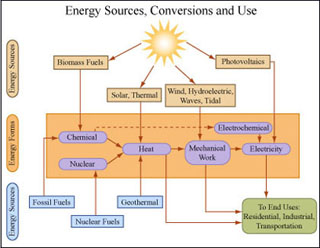-

-
Courses
Find courses by:
Collections
- About
- Donate
- Featured Sites
This is an archived course. A more recent version may be available at ocw.mit.edu.

Our sun is a major source of energy; other sources include nuclear fuels and geothermal springs. These sources can be converted into the various types of energy we use: Heat, mechanical work, and electricity. Because the conversion of heat into mechanical work cannot be 100%, some energy is always lost as heat as we use energy for residential power, industrial manufacturing, and transportation. (Image courtesy of MIT OpenCourseWare.)
Dr. Elisabeth Drake
Prof. Frank Incropera
Prof. Jefferson W. Tester
Prof. Michael Golay
10.391J / 1.818J / 2.65J / 11.371J / 22.811J / ESD.166J
January IAP 2007 - Spring 2007
Graduate
This course assesses current and potential future energy systems, covers resources, extraction, conversion, and end-use, and emphasizes meeting regional and global energy needs in the 21st century in a sustainable manner. Different renewable and conventional energy technologies will be presented including biomass energy, fossil fuels, geothermal energy, nuclear power, wind power, solar energy, hydrogen fuel, and fusion energy and their attributes described within a framework that aids in evaluation and analysis of energy technology systems in the context of political, social, economic, and environmental goals. This course is offered during the last two weeks of the Independent Activities Period (IAP), which is a special 4-week term at MIT that runs from the first week of January until the end of the month, and continues into the Spring semester.
Drake, Elisabeth, Frank Incropera, Jefferson Tester, and Michael Golay. 10.391J Sustainable Energy, January IAP 2007 - Spring 2007. (MIT OpenCourseWare: Massachusetts Institute of Technology), https://ocw.mit.edu/courses/chemical-engineering/10-391j-sustainable-energy-january-iap-2007-spring-2007 (Accessed). License: Creative Commons BY-NC-SA
For more information about using these materials and the Creative Commons license, see our Terms of Use.
